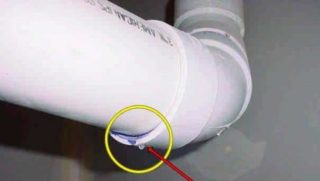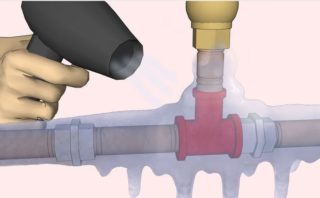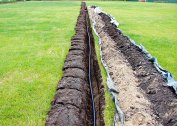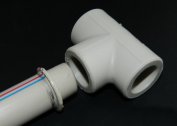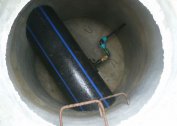Communication problems can cause significant inconvenience to residents of an apartment building and a summer cottage, since it can take more than one day to fix them. It is important to regularly monitor the system and timely repair water pipes in the apartment.
The main malfunctions of the water supply
The most common cases of malfunctioning water supply lines:
- water leakage at the joints of pipes;
- mechanical damage and wall defects;
- internal pipe frostbite in winter;
- the formation of garbage clogs.
Determining the specific type of malfunction is an important task, since it depends on what actions and who will have to take to correct the situation.
Getting rid of pipe defects
If communications have been in service for more than a dozen years, microcracks form in the pipes due to wear and tear, as a result, a breakthrough can occur. This is the most dangerous case of a water supply failure, because the liquid inside is pulled out by a dense jet under high pressure. The consequence can be serious flooding of the apartment and neighbors from below, as well as burns if the water in the pipe is hot.
At the beginning of repair of water supply networks, it is necessary to shut off the system as soon as possible in order to eliminate leakage by turning the valve near the meter. If the crack is small and imperceptible, it must be localized. Wrap the pipe with toilet paper in places where water is present outside. When a crack is found, mark it with a marker.
There are two ways to repair a leak: replace a pipe section or isolate it.
Pipe replacement
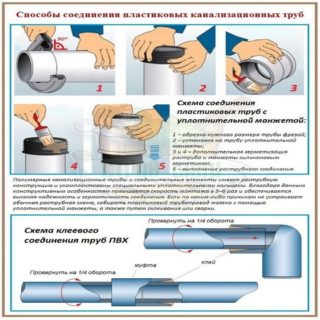 Follow the steps in the following order:
Follow the steps in the following order:
- Turn off the water supply.
- Use a grinder to make two cuts on either side of the crack, and remove the slice.
- Take a new pipe of the same length and diameter to install it in an empty space.
Pipe fastening is performed by one of two methods. The first is welding. Take the welding machine, firmly fix the inserted fragment so that it can not move. Make two quality seams around the perimeter on both sides. When you complete the process, make sure that there are no microcracks left.
The second way - fastening with special inserts. Used in the repair of plastic water pipes. Buy two threaded inserts that have the same diameter as the pipes. Insert them firmly inside or put on top, depending on the design. Do not forget to make a seal with tow. Tighten threaded plugs tightly.
Isolation of the problem area
A crack in a plastic water pipe can be repaired using a patch. To do this, you need a special textile polymer that does not leak liquid, and two clamps. Take the polymer tape and cut a scrap of such a thickness so that it is several centimeters wider than the length of the crack. Wrap material tightly and put on two pipe clamps around the edges.
Make sure that there are no wrinkles - the tape should be firmly pressed to the pipe. Tighten the clamps with a screwdriver as tight as possible. Upon completion, check how tight the insulation is. To increase reliability, it is advisable to put the polymer element on the glue.
How to get rid of leaks at the joints
To get rid of a malfunction in the water supply system at the joints of pipes, you need to know what type of fitting is used for branching the pipes. There are 4 options:
- Welded fitting.Disassembling such a system does not work, so the only way to eliminate leaks is to put additional seams with a soldering iron over the old ones.
- If the connection between the pipes is one-piece, that is, a press fitting is used, the problem area will have to be cut and 2 new couplings should be installed instead, as well as an additional pipe section between them instead of the cut one.
- If the pipe is connected to the fitting using thread or crimping technology, a leak indicates a loose connection. It is enough to tighten the connection.
- The glued fitting is sealed by crimping the problem area with a metal ring patch. Cut the ring along the axis, put on over the pipe-fitting connection, using glue to hold it together.
The site needs to be degreased before starting any compaction procedure. Otherwise, the necessary tightness will not be achieved, which increases the likelihood of relapse in the near future.
Removing ice plugs and blockages
Ice plugs inside the pipeline prevent fluid from flowing. They carry a great danger in themselves, as the pressure inside increases, causing a rupture.
First you need to determine in which place frostbite formed. To do this, thread the flexible rod into the pipe and push it further until it hits the cork. Determine the exact location of the ice along the length of the rod. Next, you need to defrost the internal icing with hot air. For this purpose, you will need a building hair dryer or burner. The main thing is to heat the pipe so that the ice inside begins to melt.
If the water supply is clogged with garbage, you need, as in the case of ice, find the location with a flexible probe. You will need a special brush for cleaning pipes, selected in diameter. It is desirable that the metal hairs are covered as densely as possible by the walls. Insert it all the way and make translational movements while scrolling around the axis. Continue such actions until the brush starts to pass further without the slightest resistance.
How to avoid water system breakdowns
All communications over time become unusable and must be replaced. Malfunctions in the operation of water supply systems can be delayed if you follow simple rules:
- Invite plumbers every six months to inspect pipes and fittings. The specialist will help you in time to identify weaknesses and avoid unpleasant surprises in the future.
- If you are replacing an old water supply, put in their place only new, proven communications without defects.
- If there are clamps or threaded couplings in your water supply, check monthly that they are tightened to the limit, as these parts tend to loosen the grip after a while.
Dirt and debris enter through the sink. Therefore, do not wash away the hair and other small waste of human life.
Who should pay for repairs
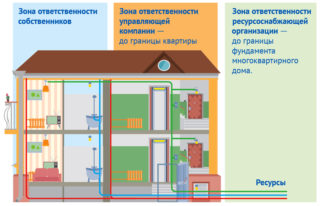 To understand who should repair water supply systems, you need to consider the type of real estate. If you are the owner of your own country house, building on a summer cottage, and you have autonomous water supply, according to the law, you must be responsible for the quality of work of all communication and engineering systems of the building.
To understand who should repair water supply systems, you need to consider the type of real estate. If you are the owner of your own country house, building on a summer cottage, and you have autonomous water supply, according to the law, you must be responsible for the quality of work of all communication and engineering systems of the building.
With housing in multi-unit city buildings, everything is a little different. There, responsibility between owners and utilities is divided according to certain rules. The company that manages the apartment building (MKD) is responsible for the vertical part of the communications on a riser that goes through several floors.
If the malfunction occurs with the horizontal part, which includes the gap between the taps and meters, the water pipe repair falls on the shoulders of the apartment owner, and he cannot demand action by the public utilities.
Measures that a tenant has the right to take in case of a malfunction of the vertical part of the water supply system:
- In the basement, shut off the water in the riser by turning the blocking valve.
- Report the incident to the Criminal Code by phone.
- Upon arrival, the repairmen require the drawing up of an act confirming the breakdown of the riser.
If a tenant has a lawsuit with flooded neighbors, the act will prove his innocence and will avoid the bill for repairs.
